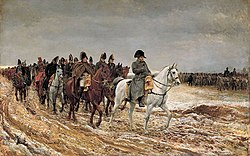Ernest Meissonier
Jean Louis Ernest Meissonier (born February 21, 1815 in Lyon , † January 31, 1891 in Paris ) was one of the most famous French painters in the 1850s and 1860s.
Life
Meissonier came to Paris young and became a student of Léon Cogniet . At the same time, Meissonier began to copy Dutch masters such as Peter Paul Rubens or Anthonis van Dyck in the Louvre . For financial reasons, Meissonier was forced to carry out commissioned work for various book printers at the beginning of his career. This resulted in illustrations for several editions of the Bible and for various works by Jacques Bénine Bossuet . “ The raging Roland ” ( Ludovico Ariosto ) was illustrated by Meissonier as well as by Jacques-Henri Bernardin de Saint-Pierre “Paul and Virginie” and “The Indian Hut”.
At the age of 21 Meissonier made his debut in 1836 at an exhibition in the Paris Salon with his genre painting “The Little Messenger and the Chess Player”. With this he had already found his style and in the next few years several works followed, such as "Monk, comforting a sick person" in 1838 or "The reader" in 1840. These subjects were enthusiastically received by the public and the official art critic almost always only found words of praise. His painting "Die Schachpartie" was awarded a medal at the exhibition in the Paris Salon in 1841.
With preference he presented people from the time of Louis XIV and Louis XV. His following, very numerous, but always executed with the utmost conscientiousness, mostly move in the same direction: a sharp but cool characteristic that does not penetrate too deeply into the soul and an elegant fabric painting.
Occasionally he also reached into the area of modern history, into the campaigns of Napoleon I and Napoleon III. over, but only achieved greater effects if he limited himself to a few figures on a small scale. Meissonier's ability to express himself is not sufficient for compositions with more figures (for example the cuirassiers from 1805) and for larger-format portraits.
In 1867 Meissonier was asked to take part in the World Exhibition in Paris . He was also represented with five paintings, "Lecture at Diderot", "The Captain", "Cavaliers in front of a tavern", "General Desaix with the Rhine Army" and "The Ordinance", some of which he had created especially for the occasion .
His work “Die Wache” was mentioned in praise at the exhibition of the Paris Salon in 1874. Meissonier did not have very many students; to be mentioned are his son Jean Charles Meissonier (* 1848), Jean Baptiste Édouard Detaille and also the German painter Fritz Werner .
Meissonier died on January 31, 1891 in Paris at the age of 75.
Works (selection)
- The Little Messenger and the Chess Player (1836)
- Monk Comforting a Sick (1838)
- The English Doctor (1839)
- The Reader (1840)
- The game of chess (1841)
- The painter in his studio (1843)
- The bodyguard
- Young man, looking at drawings
- the on-call game (1845)
- The skittles
- The soldiers (1848)
- The Bravi (1852),
- The farrier
- Napoleon I with his staff 1814
- The Poet (1859)
- Napoleon III to Solferino (1864)
- Consequences of an argument at play (1865)
- Theorbo-playing soldier (1865)
- Lecture with Diderot
- The captain
- Cavaliers in front of an inn
- General Desaix in the Rhine Army
- The orderly
- The Guard (1874)
- 1807 (Napoleon I at the Battle of Friedland)
literature
- Vallery CO Gréard: Meissonier: His Life and his Art. William Heinemann, London 1897.
- Ernest Meissonier . In: Hans Vollmer (Hrsg.): General lexicon of fine artists from antiquity to the present . Founded by Ulrich Thieme and Felix Becker . tape 24 : Mandere – Möhl . EA Seemann, Leipzig 1930, p. 347 .
- Ross King: The Judgment of Paris. The Revolutionary Decade that gave the World Impressionism . Pimlico Edition, London 2007, ISBN 978-1-84413-407-6 .
Individual evidence
- ^ Ross King: The Judgment of Paris , p. 1
Web links
- Literature by and about Ernest Meissonier in the catalog of the German National Library
- Works by Ernest Meissonier at Zeno.org .
| personal data | |
|---|---|
| SURNAME | Meissonier, Ernest |
| ALTERNATIVE NAMES | Meissonier, Jean Louis Ernest; Meissonier, Jean-Louis-Ernest; Meissonnier, Jean Louis Ernest; Meissonier, JLE; Meissonier, Gian-Luigi-Ernesto |
| BRIEF DESCRIPTION | French painter |
| DATE OF BIRTH | February 21, 1815 |
| PLACE OF BIRTH | Lyon |
| DATE OF DEATH | January 31, 1891 |
| Place of death | Paris |





